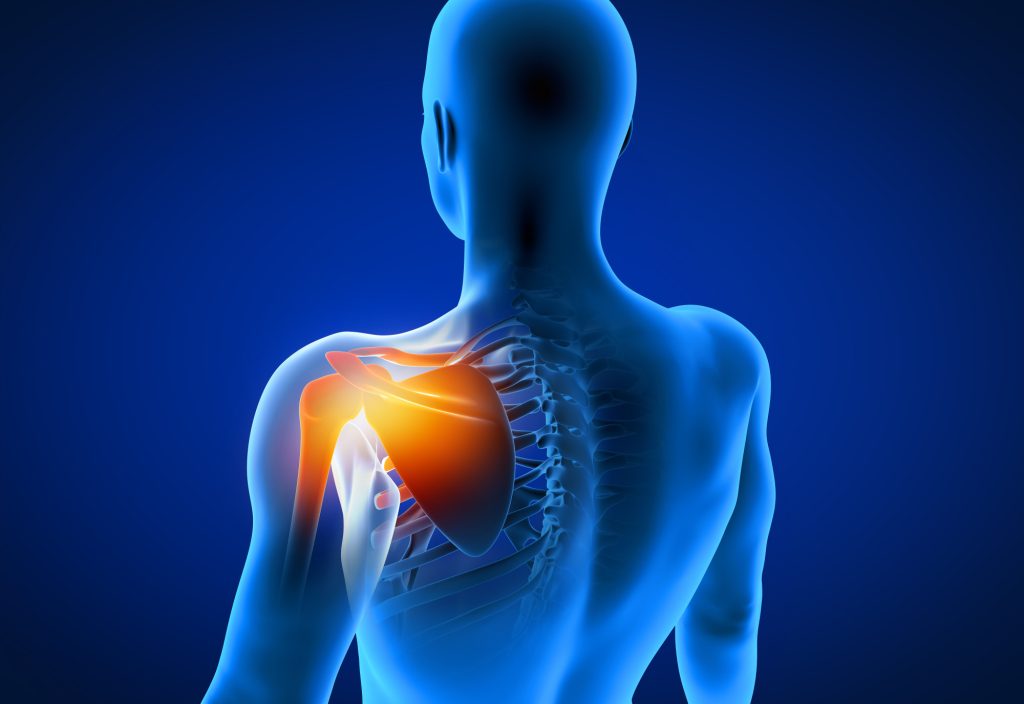
Shoulder osteoarthritis, also called degenerative bone disease, is a condition in which the cartilage that cushions the bones in the shoulder wears down. Without this protective layer, bones rub against each other, causing pain, swelling, and reduced mobility. Friction between the bones may also lead to bone spurs, which can further limit movement and increase discomfort. Other conditions, such as bursitis (inflammation of fluid-filled sacs) or rheumatoid arthritis (RA), may produce similar symptoms.
Request an AppointmentAnatomy of the Shoulder
The shoulder consists of three bones:
- Humerus: the upper arm bone
- Scapula: the shoulder blade
- Clavicle: the collarbone
These bones form two main joints:
- Acromioclavicular (AC) joint: where the collarbone meets the tip of the shoulder blade
- Glenohumeral joint: where the top of the arm bone connects to the shoulder blade
Osteoarthritis most commonly affects the AC joint.
Causes of Shoulder Osteoarthritis
Shoulder osteoarthritis can be classified as primary or secondary, depending on its cause.
Primary Osteoarthritis
- Develops gradually due to aging
- Cartilage wears thin over time, leading to pain and stiffness
- Strong genetic component; more common in certain families
Secondary Osteoarthritis
- Results from another condition or injury
- Causes may include:
- Congenital abnormalities
- Obesity
- Gout
- Traumatic injury
- Repetitive stress (e.g., sports)
- Autoimmune disease
- Alcoholism or high-dose steroid use
- Repeated joint surgeries
- Endocrine disorders
A severe type of secondary osteoarthritis, avascular necrosis, occurs when blood flow to the humerus is disrupted, causing bone cell death. This may result from trauma, alcoholism, or steroid use.
Symptoms of Shoulder Osteoarthritis
Patients with shoulder osteoarthritis commonly experience:
- Pain: Worsens with movement and may interfere with sleep
- Limited range of motion: Difficulty lifting, turning, or stretching the arm
- Abnormal joint sounds (crepitus): Clicking, snapping, or grinding from bone-on-bone contact
Diagnosis of Shoulder Osteoarthritis
Diagnosis involves a thorough physical examination to assess pain, muscle strength, and range of motion. A complete medical history helps identify family predisposition or past injuries. Additional tests may include:
- X-rays
- MRI scans
- Blood tests to rule out other conditions
- Analysis of joint fluid
Insurance Based Guidelines For The Treatment of Shoulder Osteoarthritis
Traditional medical approaches often focus on managing symptoms with pain medications, anti inflammatory medications, physical therapy and cortisone shots while degeneration continues, ultimately leading to shoulder surgery or replacement.
Michigan Integrative Health Approach To Shoulder Arthritis Treatment
Our goal is to stabilize the shoulder joint, reduce inflammation, and repair damaged tissues—without drugs or surgery.
During your consultation, exam, and assessment, we determine if you are a candidate for care. You will learn which services, products, and procedures can help:
- Increase shoulder motion
- Improve shoulder strength
- Reduce or eliminate shoulder pain
We only accept patients for care if these improvements are achievable during the initial visit. Our mission is to help you regain function, reduce suffering, and get your life back.
